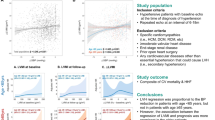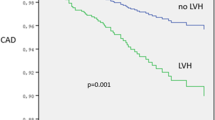Abstract
To assess the influence of age on changes in left ventricular (LV) mass and geometry during antihypertensive treatment, we related age to clinical and echocardiographic findings before and after 4 years of antihypertensive treatment in a subset of 560 hypertensive patients without known concurrent disease in the Losartan Intervention For Endpoint reduction in hypertension (LIFE) study, which randomized patients to blinded losartan- or atenolol-based treatment. Patients ⩾65 years (older group) included more women and patients with isolated systolic hypertension or albuminuria (all P<0.05). Compared to patients <65 years, older patients had higher pulse pressure, LV mass, and prevalence of concentric hypertrophy at baseline (78 vs 69 mmHg, 234 vs 224 g, and 28 vs 16%, respectively, all P<0.01), while the mean blood pressure did not differ. Over 4 years, reductions in LV mass and the mean blood pressure were similar in both groups, but older patients more often had residual hypertrophy (31 vs 15%, P<0.001) with a preponderance of eccentric geometry. In multivariate analysis of 4-year change in LV mass controlling for baseline mass, larger hypertrophy reduction was associated with losartan treatment, while age, gender, body mass index, and 4-year change in pulse pressure and albuminuria did not enter (Multiple R 2=0.40, P<0.001). Thus, in up-to-80-year-old hypertensive patients with left ventricular hypertrophy, age did not significantly attenuate hypertrophy reduction during antihypertensive treatment, although residual hypertrophy was more prevalent in older patients as a consequence of higher initial LV mass.
This is a preview of subscription content, access via your institution
Access options
Subscribe to this journal
Receive 12 digital issues and online access to articles
$119.00 per year
only $9.92 per issue
Buy this article
- Purchase on Springer Link
- Instant access to full article PDF
Prices may be subject to local taxes which are calculated during checkout
Similar content being viewed by others
References
Roman MJ et al. Impact of arterial stiffening on left ventricular structure. Hypertension 2000; 36: 489–494.
Ganau A et al. Ageing induces left ventricular concentric remodeling in normotensive subjects. J Hypertens 1995; 13: 1818–1822.
Howard BV et al. Diabetes and coronary heart disease in American Indians: The Strong Heart Study. Diabetes 1996; 45(Suppl 3): S6–S13.
Gardin JM et al. Left ventricular mass in the elderly. The Cardiovascular Health Study. Hypertension 1997; 29: 1095–1103.
Dahlöf B, Pennert K, Hansson L . Reversal of left ventricular hypertrophy in hypertensive patients. A metaanalysis of 109 treatment studies. Am J Hypertens 1992; 5: 95–110.
Omvik P, Gerdts E, Myking OL, Lund-Johansen P . Long-term central hemodynamic effects at rest and during exercise of losartan in essential hypertension. Am Heart J 2000; 140: 624–630.
Dahlöf B et al. Cardiovascular morbidity and mortality in the Losartan Intervention For Endpoint reduction in hypertension study (LIFE): a randomized trial against atenolol. Lancet 2002; 359: 995–1003.
1999 World Health Organization-International Society of Hypertension Guidelines for the Management of Hypertension. Guidelines Subcommittee. J Hypertens 1999; 17: 151–183.
Jensen JS et al. Detecting microalbuminuria by urinary albumin/creatinine concentration ratio. Nephrol Dial Transplant 1997; 12(Suppl 2): 6–9.
Devereux RB et al. Echocardiographic left ventricular geometry in hypertensive patients with electrocardiographic left ventricular hypertrophy: The LIFE Study. Blood Press 2001; 10: 74–82.
Wachtell K et al. Left ventricular filling patterns in patients with systemic hypertension and left ventricular hypertrophy (the LIFE study). Losartan Intervention For Endpoint. Am J Cardiol 2000; 85: 466–472.
Sahn DJ, DeMaria A, Kisslo J, Weyman A . Recommendations regarding quantitation in M-mode echocardiography: results from a survey of echocardiographic measurements. Circulation 1978; 58: 1072–1083.
Schiller NB et al. Recommendations for quantitation of the left ventricle by two-dimensional echocardiography. American Society of Echocardiography Committee on Standards, Subcommittee on Quantitation of Two-Dimensional Echocardiograms. J Amer Soc Echocardiogr 1989; 2: 358–367.
Gutgesell HP, Paquet M, Duff DF, McNamara DG . Evaluation of left ventricular size and function by echocardiography. Results in normal children. Circulation 1977; 56: 457–462.
Reichek N, Devereux RB . Reliable estimation of peak left ventricular systolic pressure by M-mode echographic-determined end-diastolic relative wall thickness: identification of severe valvular aortic stenosis in adult patients. Am Heart J 1982; 103: 202–203.
Teichholz LE, Kreulen T, Herman MV, Gorlin R . Problems in echocardiographic volume determinations: echocardiographic–angiographic correlations in the presence of absence of asynergy. Am J Cardiol 1976; 37: 7–11.
Devereux RB et al. Echocardiographic assessment of left ventricular hypertrophy: comparison to necropsy findings. Am J Cardiol 1986; 57: 450–458.
Roman MJ et al. Relation of arterial structure and function to left ventricular geometric patterns in hypertensive adults. J Am Coll Cardiol 1996; 28: 751–756.
Devereux RB, Dahlof B, Levy D, Pfeffer MA . Comparison of enalapril versus nifedipine to decrease left ventricular hypertrophy in systemic hypertension (the PRESERVE trial). Am J Cardiol 1996; 78: 61–65.
Gaasch WH et al. Stress-shortening relations and myocardial blood flow in compensated and failing canine hearts with pressure-overload hypertrophy. Circulation 1989; 79: 872–883.
de Simone G et al. Assessment of left ventricular function by the midwall fractional shortening/end-systolic stress relation in human hypertension. J Am Coll Cardiol 1994; 23: 1444–1451, (Erratum, J Am Coll Cardiol 1994; 24 : 844.).
Dubin J, Wallerson DC, Cody RJ, Devereux RB . Comparative accuracy of Doppler echocardiographic methods for clinical stroke volume determination. Am Heart J 1990; 120: 116–123.
Lebowitz NE et al. Prevalence and correlates of aortic regurgitation in American Indians: the strong heart study. J Am Coll Cardiol 2000; 36: 461–467.
Jones EC et al. Prevalence and correlates of mitral regurgitation in a population-based sample (the Strong Heart Study). Am J Cardiol 2001; 87: 298–304.
Hammond IW, Devereux RB, Alderman MH, Laragh JH . Relation of blood pressure and body build to left ventricular mass in normotensive and hypertensive employed adults. J Am Coll Cardiol 1988; 12: 996–1004.
Koren MJ et al. Relation of left ventricular mass and geometry to morbidity and mortality in uncomplicated essential hypertension. Ann Intern Med 1991; 114: 345–352.
Pannier B et al. Pulse pressure and echocardiographic findings in essential hypertension. J Hypertens 1989; 7: 127–132.
Lauer MS, Anderson KM, Levy D . Influence of contemporary versus 30-year blood pressure levels on left ventricular mass and geometry: the Framingham Heart Study. J Am Coll Cardiol 1991; 18: 1287–1294.
Gardin JM et al. Left ventricular diastolic filling in the elderly: the cardiovascular health study. Am J Cardiol 1998; 82: 345–351.
Zabalgoitia M et al. Disparity between diastolic mitral flow characteristics and left ventricular mass in essential hypertension. Am J Cardiol 1997; 79: 1255–1258.
Pfeffer JM, Pfeffer MA, Fishbein MC, Frohlich ED . Cardiac function and morphology with aging in the spontaneously hypertensive rat. Am J Physiol 1979; 237: H461–H468.
Acknowledgements
We acknowledge Paulette A Lyle for assistance with the preparation of the manuscript.
Author information
Authors and Affiliations
Corresponding author
Additional information
The study was supported in part by Grant COZ-368 from Merck & Co., Inc., West Point, PA, USA, and Caroline Musaeus Aarsvold's grant from The Norwegian Medical Association.
Rights and permissions
About this article
Cite this article
Gerdts, E., Roman, M., Palmieri, V. et al. Impact of age on left ventricular hypertrophy regression during antihypertensive treatment with losartan or atenolol (the LIFE study). J Hum Hypertens 18, 417–422 (2004). https://doi.org/10.1038/sj.jhh.1001718
Published:
Issue Date:
DOI: https://doi.org/10.1038/sj.jhh.1001718
Keywords
This article is cited by
-
Age-dependent implications of left ventricular hypertrophy regression in patients with hypertension
Hypertension Research (2024)
-
Regression of cardiac hypertrophy in health and disease: mechanisms and therapeutic potential
Nature Reviews Cardiology (2023)
-
Early regression of left ventricular hypertrophy after treatment with esmolol in an experimental rat model of primary hypertension
Hypertension Research (2013)
-
Changes in electrocardiographic left ventricular hypertrophy and risk of major cardiovascular events in isolated systolic hypertension: The LIFE study
Journal of Human Hypertension (2011)



